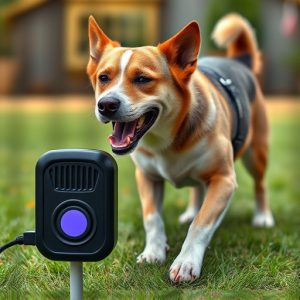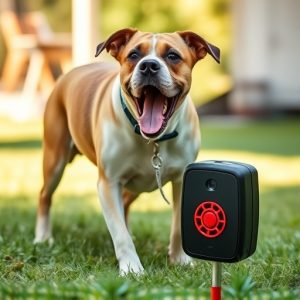Rechargeable vs Disposable Dog Repellents: Power, Features, and Safety
This text compares rechargeable vs disposable dog repellents, emphasizing rechargeables as the more…….
This text compares rechargeable vs disposable dog repellents, emphasizing rechargeables as the more sustainable and cost-effective choice for long-term use. Key benefits include longer lifespans, adjustable settings, reduced electronic waste, and potential solar charging. Disposables offer quicker protection but contribute to e-waste and have higher recurring costs. When deciding, consider power source advantages, desired protection duration, and environmental impact for the best rechargeable vs disposable dog repellent power balance.
“Unleash a powerful yet humane solution to keep unwanted pets at bay with electronic animal repellents. This comprehensive guide explores the inner workings of these innovative devices, shedding light on the age-old debate: Rechargeable vs. Disposable.
From understanding the technology behind them to dissecting key features and comparing top models, we’ve got you covered. We also delve into environmental considerations, ensuring a balanced approach to repelling pets while prioritizing safety and sustainability. Discover the perfect fit for your needs among the options available in the market today.”
- Understanding Electronic Animal Repellents: How They Work
- Rechargeable vs Disposable Dog Repellents: Benefits and Drawbacks
- Key Features to Look for in an Effective Electronic Repellent
- Top Models Comparison: Analyzing Performance, Durability, and User Feedback
- Environmental Impact and Safety Considerations: A Balanced Approach
Understanding Electronic Animal Repellents: How They Work
Electronic animal repellents, also known as ultrasonic or sound-based repellents, are innovative devices designed to keep unwanted animals away from specific areas. Unlike traditional repellents that rely on strong odours or chemicals, these modern solutions use sound waves to create an unpleasant experience for animals without causing them harm. The technology behind these repellents is relatively simple: they emit high-frequency sounds that are inaudible to humans but irritating to animals like dogs and cats.
When it comes to rechargeable vs disposable dog repellent power, the former offers a more sustainable and cost-effective solution. Rechargeable models typically use less energy overall, making them environmentally friendly. They also have longer lifespans and can be used repeatedly, which reduces waste. In contrast, disposable repellents may provide a quicker solution but contribute to electronic waste if not recycled properly. Moreover, rechargeable options often feature adjustable settings for different animal types and environments, ensuring maximum effectiveness while conserving energy.
Rechargeable vs Disposable Dog Repellents: Benefits and Drawbacks
When it comes to electronic dog repellents, one key consideration is the power source: rechargeable vs disposable. Rechargeable options offer a sustainable and cost-effective approach as they can be used again and again, eliminating the need for constant replacements. These devices are often powered by lithium-ion batteries that can last for several months with regular charging, making them a long-term investment. Moreover, many rechargeable models come with portable chargers or solar panels, allowing for convenience and versatility during outdoor activities.
On the other hand, disposable dog repellents provide an instant and hassle-free solution. These typically use replaceable batteries that can be thrown away once depleted, requiring less maintenance. They are ideal for short-term use or situations where portability is paramount. However, the environmental impact of frequent battery disposal should be considered, and the recurring cost of purchasing new batteries could add up over time.
Key Features to Look for in an Effective Electronic Repellent
When choosing an electronic animal repellent, several key features determine its effectiveness. Firstly, consider the power source – a rechargeable or disposable option. Rechargeable repellents offer cost and environmental benefits by eliminating waste from disposable batteries. However, they may require more initial investment and need regular charging. Disposable models, while pricier upfront, provide continuous protection with no maintenance needed beyond replacing the battery.
Other important features include range – how far the repellent’s signal can reach – and adjustable settings for different conditions. Some advanced models offer motion-activated functionality, ensuring the device only activates when movement is detected, enhancing efficiency and prolonging battery life. Water resistance is also beneficial, especially in outdoor settings where rain or moisture could impact performance.
Top Models Comparison: Analyzing Performance, Durability, and User Feedback
When comparing electronic animal repellents, one key factor is whether they are rechargeable or disposable. Rechargeable models offer a cost-effective and eco-friendly option, as users can simply plug them in for recharging rather than constantly buying new batteries. These devices often boast longer durations between charges, ensuring continuous protection for your space. In contrast, disposable repellents are convenient for short-term use or areas with less frequent animal intrusion. They provide immediate protection but at the cost of frequent battery replacements.
User feedback plays a significant role in understanding the performance and durability of these products. Many users appreciate the convenience of rechargeable models, as they require less maintenance and offer better value over time. Durable construction is also essential; devices that can withstand outdoor elements and prolonged use are more likely to provide consistent results. Comparatively, disposable repellents may receive praise for their quick setup and effectiveness in specific scenarios but might be viewed negatively for their short lifespan and recurring expense.
Environmental Impact and Safety Considerations: A Balanced Approach
The environmental impact and safety considerations are crucial aspects when discussing electronic animal repellents, especially as their popularity grows. One key factor to consider is the choice between rechargeable and disposable dog repellents. Rechargeable options offer a more sustainable approach by reducing waste associated with disposable batteries. This eco-friendly angle gains significance in light of the potential long-term use of these devices, making recharging a more viable solution than frequent battery replacements.
Safety is another critical element. Electronic repellents must be designed with user safety in mind, ensuring they are not a risk to pets or humans. Features like automatic shut-off mechanisms and controlled emission levels can contribute to this balance. By prioritizing both environmental sustainability and safety, manufacturers can create dog repellents that offer an effective, yet responsible, solution for managing animal behavior.
When choosing an electronic animal repellent, considering the balance between rechargeable vs. disposable dog repellents is key. Both options offer unique benefits and drawbacks in terms of power, cost-effectiveness, and environmental impact. By understanding these dynamics, pet owners can make an informed decision that not only keeps their spaces safe but also promotes a sustainable approach. Look for features like adjustable settings, durable construction, and positive user feedback to ensure the best results. In the end, selecting the right repellent allows you to maintain a harmonious relationship with your furry friends while protecting your property.


